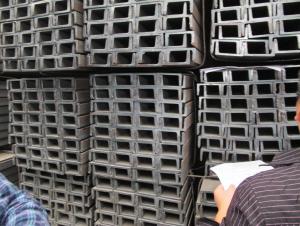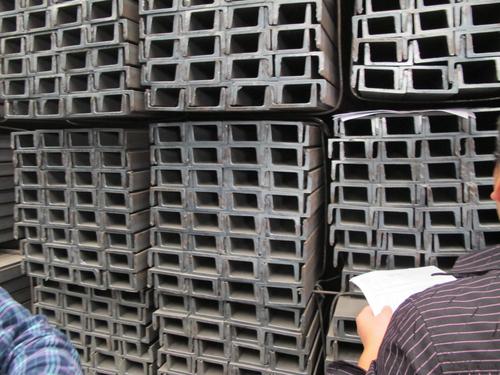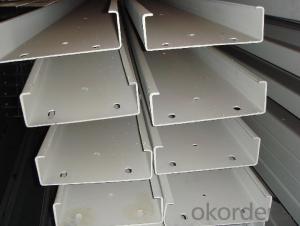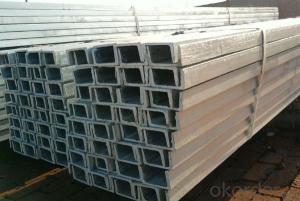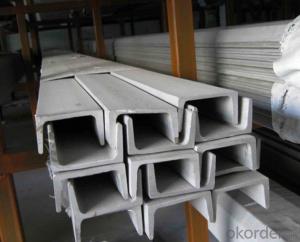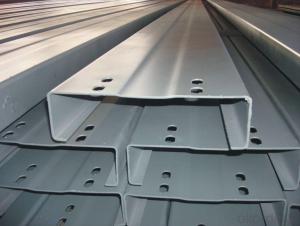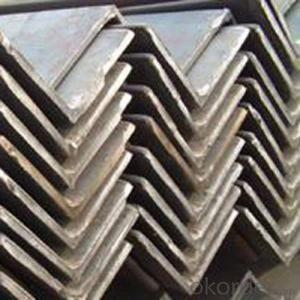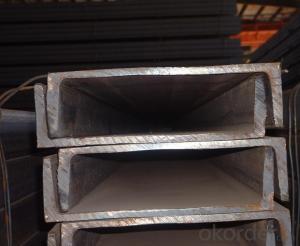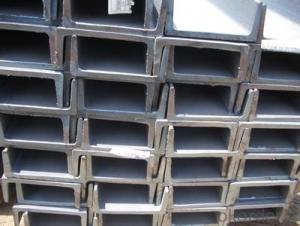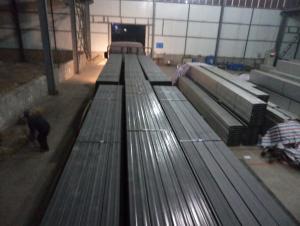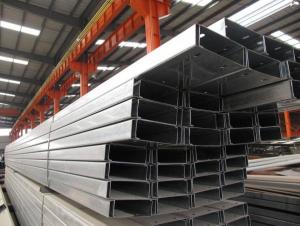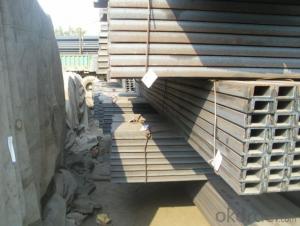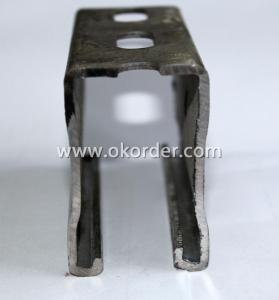Hot Rolled JIS Standard Channel with Many SIzes
- Loading Port:
- China Main Port
- Payment Terms:
- TT or LC
- Min Order Qty:
- -
- Supply Capability:
- -
OKorder Service Pledge
OKorder Financial Service
You Might Also Like
Product Description:
OKorder is offering STEEL CHANNEL at great prices with worldwide shipping. Our supplier is a world-class manufacturer of steel, with our products utilized the world over. OKorder annually supplies products to European, North American and Asian markets. We provide quotations within 24 hours of receiving an inquiry and guarantee competitive prices.
Product Applications:
1.The JIS channel can be devided into two kinds, namely common channel steel and light channel steel. The sizes of hot rolled common channel steel range from 5# to 40#. Meanwhile, the channel steel can be divided into cold forming sectional equal channel steel, cold forming sectional unequal channel steel, cold forming inner edge channel steel and outer edge channel steel.
2.The JIS channel is usually used for arch-itechtural structure, and they could be welded in order to support or hang a vari-ety of facilities. They are also usually used in combination with I beam. The channel steel with sizes under 14# is usually applied to construction engineering, as purline, while the channel steel with sizes above 16# is more likely to be used in building vehicle chassis structure and mechanical structure. Furthermore, the channel steel in sizes above 30# are target at building bridge structure, as tension bar.
3.In a word, the channel steel must possess perfect welding property, riveting property and mechanical property and so on.
Product Advantages:
OKorder's STEEL CHANNELare durable, strong, and resist corrosion.
Main Product Features:
· Premium quality
· Prompt delivery & seaworthy packing (30 days after receiving deposit)
· Corrosion resistance
· Can be recycled and reused
· Mill test certification
· Professional Service
· Competitive pricing
Product Specifications:
Minimum Order Quantity: 25 Tons Unit: m.t. Loading Port: Xingang Port
Supply Ability: 1000 Tons Per Day Payment Terms: TT or L/C
Product Description:
Specifications of Steel U Channel:
Standard Applied: GB Standard, EN Standard(UPN), JIS Standard
Sizes: 50mm to 300mm
Material Grade: Q235B, Q345B, S235JR, SS400, ASTM A36
Production Flow of JIS Channel:
1.The steel billet shall be heated in the high temperature furnace.
2. The heated steel billet shall be rolled five to nine times with the aim of shaping the general figure of steel u channel.
3. The rolled steel channel should be put onto the cooling bed to make the temperature low.
4. The JIS Channel should be straighted on the straightener.
5. The straighted steel u channel will be cut into meters by saw, as per customer's requirements.
6. At the last part of production, the channel steel must be tested in order to confirm that the finished products are completely free from crack, pore, slag, scab or fold on the surface.
Package & Delivery: Steel U Channel
The steel u channel will be packed in bundle with steel wire at each end of every bundle and color marking in order to help the customer to recognize his goods more easily at sight.
And steel u channel could be loaded into 20ft or 40ft container, or by bulk cargo. If the weight of each bundle reaches less than 3.5 mt, the loading by break bulk cargo should be choosed. When the weight of each bundle reaches less than 3mt, the loading by container should be choosed.
As for the transportaion from mill to loading port, the truck will be usually used. And the maximum quantity for each truck is 40mt.
All in all, we could do in accordance with customer's request
JIS CHANNEL | Standard h | Sectional b | Dimension s | t | Mass: Kg/m |
| (mm) | (mm) | (mm) | (mm) |
|
50x25 | 50 | 25 | 3.0 | 6.00 | 2.37 |
75X40 | 75 | 40 | 3.8 | 7.00 | 5.30 |
75X40 | 75 | 40 | 4.0 | 7.00 | 5.60 |
75X40 | 75 | 40 | 4.5 | 7.00 | 5.85 |
75X40 | 75 | 40 | 5.0 | 7.00 | 6.92 |
|
|
|
|
|
|
100X50 | 100 | 50 | 3.8 | 6.00 | 7.30 |
100X50 | 100 | 50 | 4.2 | 6.00 | 8.03 |
100X50 | 100 | 50 | 4.5 | 7.50 | 8.97 |
100X50 | 100 | 50 | 5.0 | 7.50 | 9.36 |
|
|
|
|
|
|
125X65 | 125 | 65 | 5.2 | 6.80 | 11.66 |
125X65 | 125 | 65 | 5.3 | 6.80 | 12.17 |
125X65 | 125 | 65 | 5.5 | 8.00 | 12.91 |
125X65 | 125 | 65 | 6.0 | 8.00 | 13.40 |
|
|
|
|
|
|
150x75 | 150 | 75 | 5.5 | 7.30 | 14.66 |
150x75 | 150 | 75 | 5.7 | 10.00 | 16.71 |
150x75 | 150 | 75 | 6.0 | 10.00 | 17.90 |
150x75 | 150 | 75 | 6.5 | 10.00 | 18.60 |
150x75 | 150 | 75 | 6.5 | 10.00 | 24.00 |
|
|
|
|
|
|
200X80 | 200 | 80 | 7.5 | 11.00 | 24.60 |
Images:


- Q: Are steel channels suitable for electrical conduit systems?
- Yes, steel channels can be suitable for electrical conduit systems. Steel channels provide durability, strength, and protection for electrical wires and cables. They can withstand harsh environments, offer high load-bearing capacity, and protect against mechanical damage. Additionally, steel channels can be easily installed and provide a reliable and long-lasting solution for electrical conduit systems.
- Q: How do steel channels contribute to the overall functionality of a building?
- Steel channels play a crucial role in the overall functionality of a building through various means. Firstly, they provide structural support and stability by functioning as load-bearing members. These channels are specifically designed to distribute weight and forces throughout the building, enabling it to withstand different loads, including dead loads (the building's weight) and live loads (people, furniture, equipment). Furthermore, steel channels are commonly used in framing systems for walls, roofs, and floors. They help establish a rigid framework that supports the building envelope, allowing for the creation of open and flexible spaces. Additionally, they aid in the creation of partitions and the division of spaces within the building, providing a framework for walls and other structural elements. Moreover, steel channels possess exceptional durability and resistance to environmental factors such as fire, moisture, and pests. This durability ensures the long-term integrity of the building, reducing maintenance needs and increasing its lifespan. From a functional standpoint, steel channels also contribute to the overall efficiency of a building. They can be prefabricated, leading to faster and more efficient construction processes. The dimensional accuracy and uniformity of steel channels make them easier to work with, ensuring precise assembly and minimizing construction errors. Additionally, steel channels can accommodate other building systems and components, including electrical wiring, plumbing, and HVAC systems. They provide a convenient pathway for these utilities, facilitating efficient installation and maintenance. To summarize, steel channels are indispensable elements that enhance the overall functionality of a building. They provide essential structural support, stability, and durability, while also facilitating efficient construction and integration of other building systems.
- Q: What are the common surface treatments for steel channels?
- The common surface treatments for steel channels include galvanizing, painting, and powder coating.
- Q: Can steel channels be welded or bolted together?
- Yes, steel channels can be welded or bolted together.
- Q: What are the different grades of steel used for channels?
- There are several different grades of steel that are commonly used for channels. The specific grade of steel used will depend on the intended application and desired properties. One commonly used grade is A36 steel, which is a low carbon steel known for its excellent weldability and versatility. It is often used for structural applications, including channels, due to its strength and durability. Another frequently used grade is A572 steel, which is a high-strength, low-alloy steel. It offers improved strength and corrosion resistance compared to A36 steel, making it suitable for more demanding applications such as heavy-duty construction projects. Other grades of steel that may be used for channels include A588 steel, which is a weathering steel known for its corrosion resistance, and A500 steel, which is a structural steel commonly used in construction and infrastructure projects. It is important to consult with a structural engineer or steel supplier to determine the most appropriate grade of steel for a specific channel application, taking into consideration factors such as load-bearing capacity, corrosion resistance, and environmental conditions.
- Q: What are the different shapes of steel channels available?
- There are several different shapes of steel channels available in the market. Some of the common shapes include: 1. C-Channel: This is the most commonly used shape of steel channel, which resembles the letter "C". It has a flat base and two perpendicular sides. C-channels are versatile and widely used in construction and structural applications. 2. U-Channel: U-channels are similar to C-channels but have a slightly different shape, resembling the letter "U". They have a flat base and two perpendicular sides, but the sides are typically shorter than C-channels. U-channels are commonly used for edging, framing, and support purposes. 3. Hat Channel: Hat channels, also known as furring channels or resilient channels, have a unique "hat-like" shape, with a flat base and two parallel sides that taper towards the top. These channels are primarily used as a support system for attaching gypsum boards or other wall materials. 4. Box Channel: Box channels, also known as rectangular channels, have a square or rectangular shape. They have four equal sides and are often used for structural applications where strength and rigidity are required. 5. Z-Channel: Z-channels have a distinctive "Z" shape, with two parallel sides that are connected by a vertical middle section. These channels are commonly used in construction for framing, bracing, and supporting applications. 6. Lipped Channel: Lipped channels, also known as lip channels or lip sections, have an additional lip or flange on one side. This lip provides extra strength and rigidity, making lipped channels suitable for heavy-duty applications such as structural support and framing. These are just a few examples of the different shapes of steel channels available. The choice of shape depends on the specific application and the required strength and functionality of the channel.
- Q: Can steel channels be used for balcony construction?
- Yes, steel channels can be used for balcony construction. Steel channels provide structural support and can be used to create a sturdy base for balcony construction. They offer strength, durability, and resistance to various weather conditions, making them a suitable choice for balcony construction.
- Q: Can steel channels be used in the construction of agricultural buildings?
- Yes, steel channels can be used in the construction of agricultural buildings. Steel channels are strong, durable, and can withstand heavy loads, making them suitable for various structural applications, including the construction of agricultural buildings. They are commonly used for framing, support beams, and trusses in agricultural structures such as barns, warehouses, and storage buildings. Steel channels offer excellent resistance against corrosion, pests, and fire, making them a reliable choice for agricultural construction projects.
- Q: Own attic, choose I-beam or channel?
- Oneself take attic, suggest to choose I-beam, and choose GB steel, because stainless steel in non GB is more.I-beam is a kind of economical section steel with better mechanical performanceFeatures: I-beamWide flange and large lateral rigidity. Good bending resistance.The two surfaces of the flanges are mutually parallel so that the connection, processing and installation are simple and convenient.Compared with the general steel, the utility model has the advantages of low cost, high precision, little residual stress, no expensive welding materials and welding seam detection, and the cost of steel structure production is saved by about 30%.Under the same section load, the weight of hot-rolled H steel structure is less than that of traditional structure 15%-20%.Compared with the concrete structure, the I-beam structure can increase the use area of 6%, while the weight of the structure can be reduced by 20% and 30%, and the internal force of the structural design can be reduced.The I-beam can be processed into T steel, and the castellated beams can form various section forms to meet the demands of engineering design and manufacture.
- Q: Can steel channels be used in multi-story buildings?
- Multi-story buildings can indeed utilize steel channels. These steel channels, also referred to as C-channels or structural channels, are commonly employed in construction due to their robustness and endurance. They offer structural reinforcement and are frequently employed as framing components in numerous applications, including multi-story buildings. Steel channels possess a combination of lightweight and strength, rendering them ideal for multi-story buildings where weight plays a critical role. Their fabrication and installation are simple, which reduces construction time and expenses. Furthermore, steel channels exhibit excellent resistance to fire, corrosion, and other environmental factors, ensuring the long-term stability and safety of the building. Within multi-story buildings, steel channels can be employed as beams, columns, or bracing elements to distribute the load and provide stability. They can withstand the weight of floors, walls, and roofs, while also enduring dynamic forces such as wind and seismic loads. Through meticulous engineering and design considerations, steel channels can efficiently manage the vertical and horizontal loads that arise in multi-story buildings. Moreover, steel channels can seamlessly integrate with other structural systems, such as steel frames or reinforced concrete, to establish a sturdy and adaptable building structure. Their versatility allows for a broad range of design possibilities, accommodating different architectural styles and functional requirements. In conclusion, steel channels are a suitable option for multi-story buildings due to their strength, durability, and versatility. They offer structural support, resist environmental factors, and can be easily integrated into the building's framework.
Send your message to us
Hot Rolled JIS Standard Channel with Many SIzes
- Loading Port:
- China Main Port
- Payment Terms:
- TT or LC
- Min Order Qty:
- -
- Supply Capability:
- -
OKorder Service Pledge
OKorder Financial Service
Similar products
Hot products
Hot Searches
Related keywords
